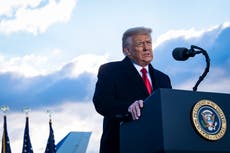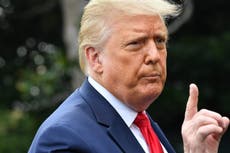Trump impeachment: US to relive Capitol riot nightmare as Senate trial begins
Senate leaders from both parties looking forward to a 'fair' trial
The stage is set for the second impeachment trial of Donald Trump in the last 13 months after Senate leaders agreed to a rules package on Monday governing the proceedings.
And while Mr Trump is all but assured to be acquitted with most Republicans already indicating they oppose the trial on constitutional grounds, the spectacle is certain to reopen fresh wounds for a nation still reeling from the nightmarish scenes at the Capitol on 6 January.
President pro tempore of the Senate Patrick Leahy will officially draw open the curtains on the trial at 1pm on Tuesday, presiding over the chamber as senators listen to four hours of arguments from both sides about the constitutionality of putting a former president on trial.
Beginning at noon on Wednesday, the nine House impeachment managers, led by Maryland Democrat Jamie Raskin, will have 16 hours over two days to present their case against Mr Trump.
The former president stands accused of inciting the deadly insurrection at the US Capitol on 6 January where a mob of his supporters overran police lines and sacked the legislature, interrupting Congress’ certification of Joe Biden’s electoral victory from two months prior.
On Friday, Mr Trump’s legal team will mount his defence, another 16-hour allotment of time that will extend into the weekend.
Both sides can call witnesses with the approval of a chamber majority, per Mr Raskin’s request.
“Each side will have ample time to make their arguments,” Senate Majority Leader Chuck Schumer said on Monday, announcing his agreement with Minority Leader Mitch McConnell on the rules package.
Both men have characterised the structure of the process as “fair.”
The Constitution question
The trial will commence on Tuesday with four hours of debate on Mr Trump’s main line of defence: whether the Senate has the authority under the US Constitution to try the former president on his article of impeachment for “incitement of insurrection.”
If anyone can go toe-to-toe against the Trump defence team about such questions, it is Mr Raskin, the third-term Democratic congressman whose 58 years on this earth have been a lifelong study of America's four-page founding document.
The impeachment managers’ brief from 2 February enumerates multiple cases throughout US history where a former official has stood trial for impeachment.
That memo also highlights the obvious loopholes for justice permitted by a reading of the Constitution that prohibits post-service trials.
“The Constitution does not allow officials to escape responsibility for committing impeachable offences by resigning when caught, or by waiting until the end of their term to abuse power, or by concealing misconduct until their service concludes,” the Democratic memo argues.
What’s more, it emphasises, the language of the Constitution plainly states in Article I, Section 3, Clause 6: “The Senate shall have the sole Power to try all Impeachments.”
The House impeached Mr Trump on 13 January, seven days before he left office.
Ahead of the trial, Mr Trump's lawyers and Republican senators have mostly leaned on the fringe legal theory that presidents cannot be impeached after they have left office.
As the ex-president’s memo published on Tuesday states: “In this instance ... the Senate is being asked to do something patently ridiculous: try a private citizen in a process that is designed to remove him from an office that he no longer holds.”
It continues: “Conviction at an impeachment trial requires the possibility of a removal from office. Without that possibility, there cannot be a trial.”
The vast majority of constitutional scholars — spanning the ideological spectrum — have rejected that line of logic, pointing to a successful impeachment conviction’s second potential penalty: barring the convicted from every holding public office again.
The impeachment managers rebutted the Trump team’s constitutional argument on Tuesday asserting it defied logic and the wishes of the document’s framers to allow a public official to avoid the political consequences of his actions by simply resigning from office before — or in the midst of — an impeachment trial.
“Presidents swear a sacred oath that binds them from their first day in office through their very last,” the Democratic response reads. “There is no ‘January Exception’ to the Constitution that allows Presidents to abuse power in their final days without accountability.”
An emotional appeal
The impeachment managers’ 80-page pre-trial brief submitted on 2 February provides a roadmap for their prosecution of Mr Trump, which will centre around a harrowing narrative of chaos, death, and lasting trauma for a nation that watched in horror as its elected representatives fled and ducked for their lives.
The impeachment managers’ memo recounts in exhaustive detail the violence and fear inside the Capitol as the pro-Trump mob menaced lawmakers, staff, journalists, police, and others.
As rioters stampeded through the Capitol complex, Mr Raskin “asked his chief of staff to protect his visiting daughter and son-in-law ‘with her life’ — which she did by standing guard at the door clutching a fire iron while his family hid under a table,” the managers’ brief recalls.
Speaker Nancy Pelosi’s staff “hid under a table with the lights turned off for hours while they could hear rioters outside in the Speaker’s office,” it adds.
The managers have included another detail that is certain to provide shock value and draw out an emotional response from many senators who are set to hear their case:
“One insurrectionist paraded the Confederate battle flag through the Capitol halls — an act that thousands of troops gave their lives to prevent during the Civil War.”
The managers have indicated they will show video footage of the rioters and Mr Trump’s speech beforehand, one of their central pieces of evidence that he incited the attack.
There are numerous examples of rioters who have since been arrested indicating their belief that they were “invited” to the Capitol by Mr Trump.
Mr Trump, the managers will claim, ought to have known his militant followers would take his exhortations to “fight” for the preservation of his presidency as literal, direct orders.
Which they did.
“After the insurrection, one participant who broke into the Capitol wearing combat gear and carrying zip ties stated that he acted because ‘[t]he President asked for his supporters to be there to attend, and I felt like it was important, because of how much I love this country, to actually be there,’” the Democrats’ memo from 2 February states.
Another woman quoted by the impeachment managers later told authorities: “I thought I was following my President. … He asked us to fly there, he asked us to be there, so I was doing what he asked us to do.”
The defence
The way Mr Trump’s lawyers tell it, the ex-president was merely exercising his First Amendment rights when he called the 2020 election results into question day after day in the weeks following 3 November.
And he is not to blame for the perpetrators of the ensuing attack on the Capitol on 6 January, who his lawyers have characterised as “a small group of criminals” who acted “of their own accord and for their own reasons.”
The Trump team’s argument against the merits of the impeachment charge hinges on the connotations of that particularly thorny word: “fight.”
In his speech at the Ellipse just south of the White House on 6 January, and in statements prior to the uprising, the former president used the term “fight” in the “figurative sense that has long been accepted in public discourse when urging people to stand and use their voices to be heard on matters important to them,” his lawyers have written.
In a vacuum, that argument is fair: the term “fight” has been employed by virtually every lawmaker in recent US history at one time or another to promote a bevy of political causes across the left-right spectrum.
The phrase, Mr Trump’s team argues, “was not and could not be construed to encourage acts of violence.”
The problem with that claim, according to the impeachment managers?
Thousands of Mr Trump’s supporters took his words literally, as noted previously. And the Trump administration was aware his supporters were taking them literally.
The mobilisation effort for the MAGA march on the Capitol was “widely discussed on websites — such as TheDonald.win — that, as confirmed by a former White House staff member, were ‘closely monitored’ by President Trump’s social media operation,” the impeachment managers’ memo from 2 February states, citing an article penned by The Independent’s Andrew Feinberg.
TheDonald.win webpage was home to “hundreds of posts about plans for the attack on the Capitol, with detailed discussions of weaponry and directions to ‘find the tunnels’ and ‘arrest the worst traitors,’” the memo alleges.
Mr Trump’s lawyers will also be fighting back against claims that the president sat on his hands as a co-equal branch of government was being physically overrun by a group of supporters he had addressed just hours earlier.
The impeachment managers intend to provide evidence that Mr Trump not only organised and incited the riot, but that he failed to protect members of Congress — and his own vice president — once it had spiralled out of control.
“Senior administration officials described President Trump as ‘delighted’ and reported that he was ‘walking around the White House confused about why other people on his team weren’t as excited as he was as you had rioters pushing against Capitol Police trying to get into the building,’” the managers’ memo states.
According to subsequent news reports, it eventually took the intervention of his chief of staff, Mark Meadows, to prod the president into taking some kind of action.
“They are going to kill people,” Mr Meadows told Mr Trump, according to the memo.
A Capitol on edge
Nearly five weeks since the insurrection, the entire Capitol complex and several surrounding federal buildings remain barricaded from the public, bordered by an eight-foot fence domed with a spiral spool of barbed wire.
Thousands of members of the National Guard — a fraction of the 25,000 in the nation’s Capitol during Mr Biden’s inauguration — have stayed behind to help the US Capitol Police patrol the perimeter as well as the legislature’s storied hallways.
Citing ongoing domestic terrorism threats, the USCP will keep its heightened security measures in place through at least the impeachment trial.
Leadership at the department has advocated for leaving the fence up for good, a proposal that has attracted vehement opposition from lawmakers and journalists alike.
House members now face up to $5,000 fines for sidestepping the metal detectors that have been erected before entrances to the chamber floor.
While law enforcement officials have told multiple news outlets they’re dealing with any specific threats at the moment, several detainment documents filed against suspects from the 6 January riot highlight the ongoing security threat right-wing extremists pose to people’s safety.
"If nothing else, the events of January 6, 2021, have exposed the size and determination of right-wing fringe groups in the United States, and their willingness to place themselves and others in danger to further their political ideology,” one such memo from the DOJ in the state of Washington reads.
“Releasing Defendant to rejoin their fold and plan their next attack poses a potentially catastrophic risk of danger to the community,” the document states.
Join our commenting forum
Join thought-provoking conversations, follow other Independent readers and see their replies
Comments




Bookmark popover
Removed from bookmarks